2007 VOLKSWAGEN JETTA drive
[x] Cancel search: drivePage 268 of 477

Booklet 3.1 Controls and Equipment
Appl ies to vehicles: with electrically adjusta ble fron ts sea t an d memory bu ttons
Assigning dr iver seat settings to a remote control key
S eat settings can be assigned to each remote control key so that the driver seat is
automatically adjusted to fit a particular driver's size and height.
Ass igning remote control keys
-Do not take more than 10 second s when
performing steps 1-4, othe rw ise the re
mote control key will not be assign ed and
your setting s will not be stored .
- Adju st y our seat and a ssign the adjust
ments to a memory button.
Applies to vehicles: with seat heating
Heated front seats
-Remove the key from the ignition lock.
- Push the unlock symbol
32,
14 the remote contro l twice . You
will hear an acou sti c s igna l to let you k now
that the seat positions have be en ass ign ed.
The remote key is s et. •
The seat cushions and backrests of the front seats can be heated electrically.
Fig. 47 Detai l o f i ns trume nt panel : thu mb w heels
for front seat h eating
- Turn rhe left or right whe el 47
Th e se at heating i s switch ed off in the O po
s it ion.
Th e se at heating only work s when the ignition is
s wit ch ed on. Th e le ft thumb whe el co ntrol s the
l e ft sea t and the right thumb whee l th e right seat
Note
D o no t kneel on the se at or apply sharp pressur e
at a sing le point to the seat cu shi on and back
re st. Thi s can dama ge th e heating ele m en ts. •
Seats and storage 65
Page 278 of 477
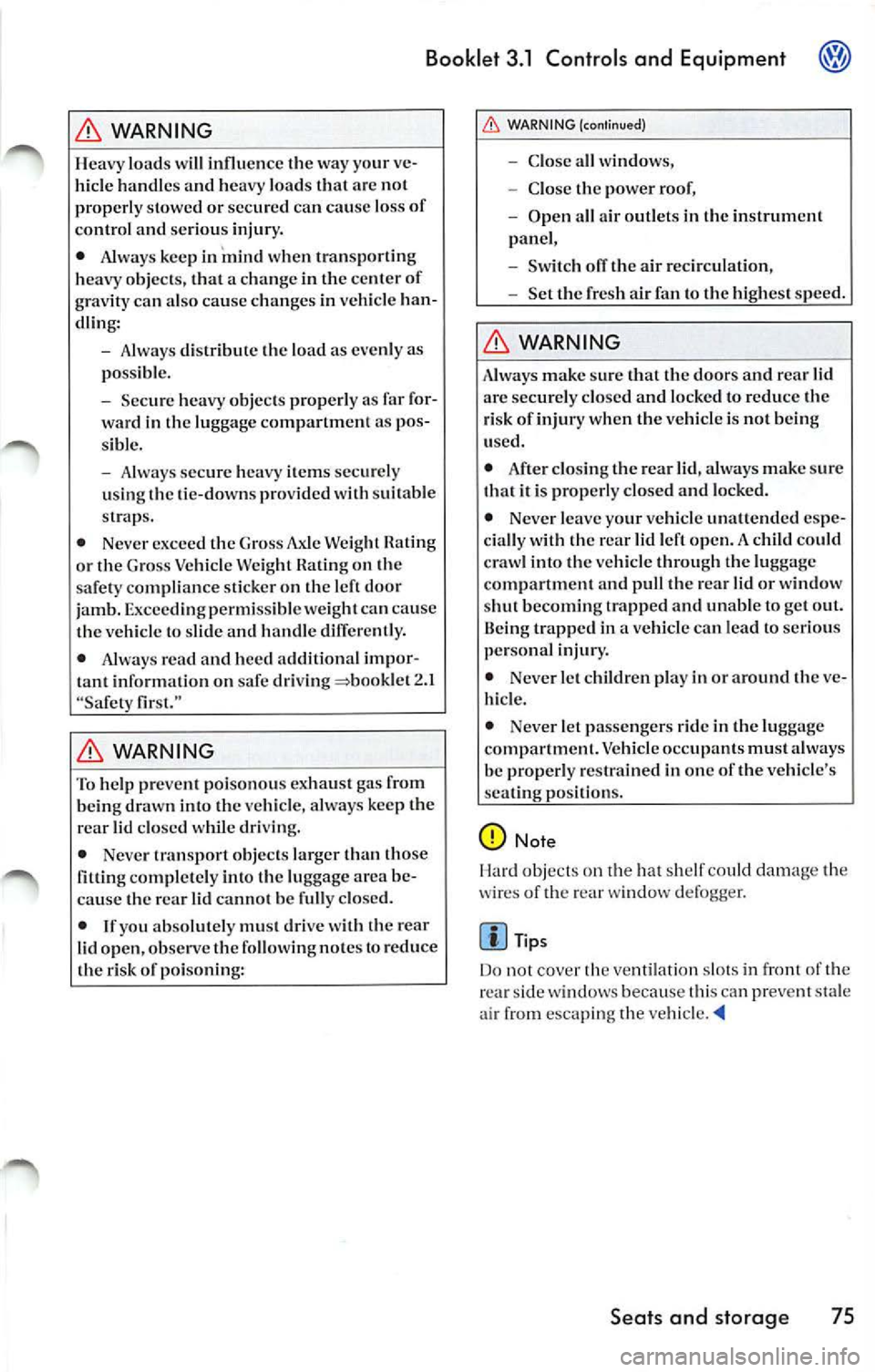
Booklet 3.1 Controls and Equipment
WARNING
Heavy load s will influ ence the way your ve
hicle handl es and heavy loads t hat are not
properly stowe d or sec ured can cause loss of
contro l a nd se rious injury.
• Always keep in
when transporting
h eav y ob ject s, that a chan ge in th e center of
gravity can also cause c hanges in vehicle han
dling:
-Always distribute the load as evenly as
po ssib le.
- Secur e heavy object s properly as far for
ward in the lug gage compar tment as pos
sible.
- Alwa ys s ecure heavy items securely
using the tie-downs provided wit h suitable
s trap s.
• Never excee d the Gross Axle Weight
or the Gross Ve hicle Wei ght Hating on the
s afe ty compliance sticker o n th e left d oor
jamb. Exceedi ng permi ssible weig ht can ca use
the vehicle to slide and handle difTerently.
• Always read and heed a ddition al imp or
in forma tion on driving 2.1
" Safety first."
WARNING
To help p rev en t poisonou s exhaust gas from
being drawn into the vehicle , a lways ke ep the
rear lid clo sed w hile driving.
• Never transport objects larger than those
fitting completely into the luggage area be
cause t he rear lid cannot be full y closed.
• If you abso lut ely must drive with the rear
li d open, observe the following notes to reduce
th e risk of poisoning:
WARNING (continued)
-Close all wind ows,
- Close the power roof,
- Open all air outlets in the in strumen t
panel,
- Switch off the air recirculation,
- Set the fresh air fan to the highest speed.
WARNING
Always make sur e that the doors and rear lid
are secure ly clo sed and locke d to redu ce the
risk of injury when the vehicle is not being
u sed.
• Afte r clo sing the rear lid , a lways mak e sur e
that it is p roper ly closed and locked.
• Never leave yo ur vehicle unattended espe
cially with th e rear lid left open. A child could
craw l into the vehicle through the luggage
compartment a nd pull the re ar lid or window
s hut becoming trapped and unab le to get ou t.
Being trapped in a ve hicle can lead to serious
p ersona l inju ry.
• Never le t ch ildr en play in or around the ve
hicle.
• Never let passe ngers ride in the luggag e
com par tmenl. Vehicl e occupants must always
be properl y re strained in one of the veh icle's
s eat ing po siti on s.
Note
o bj ec ts o n th e hat sh elf co uld d am age the
w ires of the re a r w ind ow d efogg er.
Tips
D o no t co ve r th e ve ntilatio n slo ts in front of th e
r e ar sid e w ind ows beca use this ca n pr event sta le
a ir fr om esca ping the vehi cle.
Seats and storage 75
Page 286 of 477
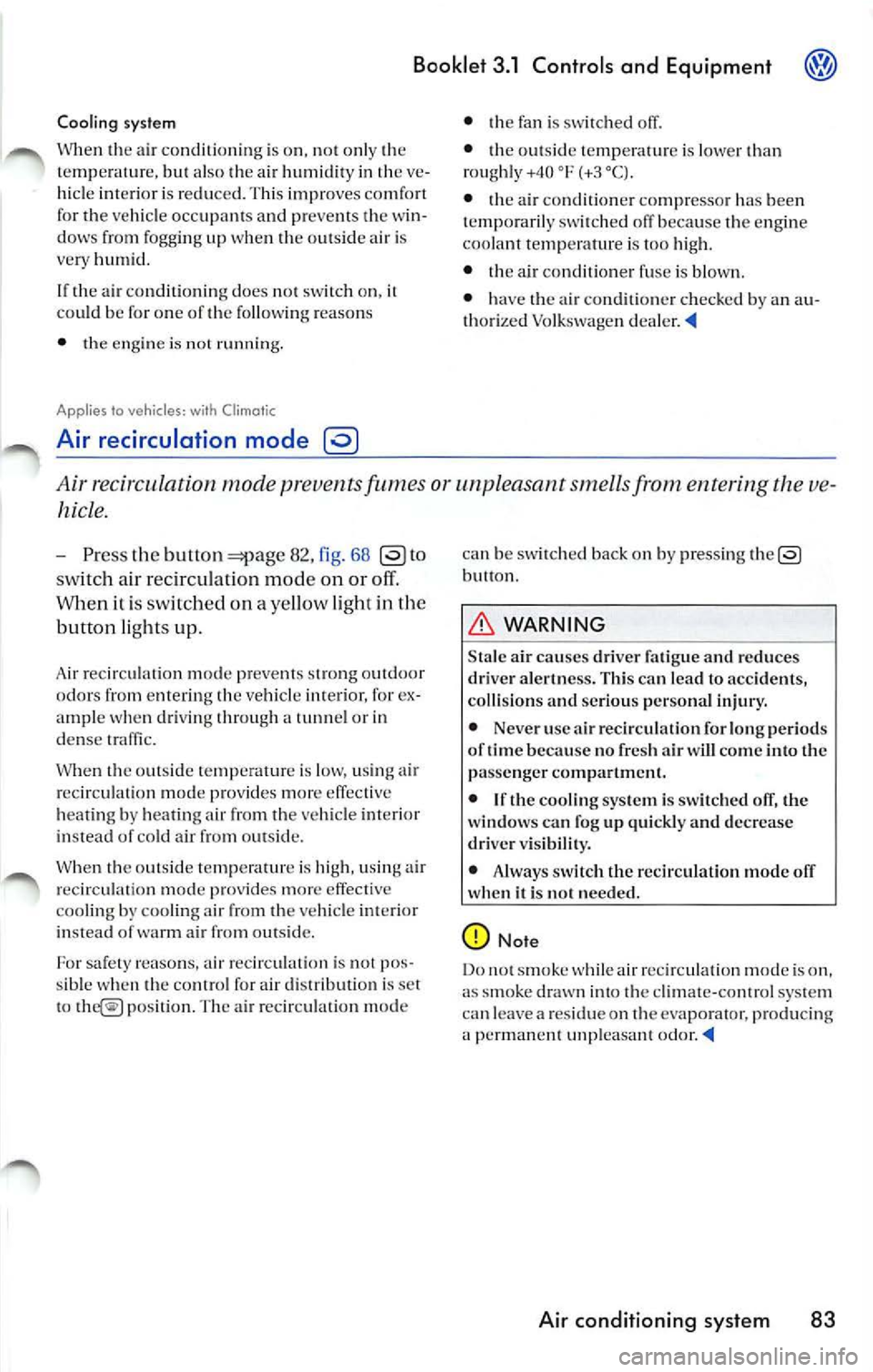
Booklet 3.1 Controls and Equipment
Cooling system
When the air condit ion ing is on, not on ly th e
temperatur e, but also the air humidit y in th e ve
h icle interior is re du ced. Thi s improve s comfort
for the vehicle occupallls and preve nts th e w in
dows from fogging up when th e o utsi de a ir i s
very humid.
I f the air conditionin g does not
on, it
co uld be for one of the follow ing reasons
• the eng ine is no t running.
Applies to vehicles: with Climatic
Air recirculation mode
• th e fan is sw itch ed off.
• t he outs id e te mperatu re is lower than
rou ghly
+ 40 ( +3 °CJ .
• the air conditioner compr essor has bee n
tempor aril y sw it ched off because th e e ngi ne
coo la nt te mp erature i s too high.
• the air condition er fu se is blow n.
• have the air condit ione r ch ecked by an au
th ori ze d Vo lkswage n deale r.
Air recirculat ion mod e prevent s fum es or unpleasant smells from entering the ve
hicle.
- Pre ss the butt on 82, 68
switch air r eci rculat io n mode on or off.
When it is s witch ed on a yellow light in the
button light s up.
Air r ecircul atio n m ode pre vents stro ng out door
odors from ent erin g th e ve hicle interior, for ex
amp le when driving th rough a tunnel or in
de nse traffi c.
the out side te mp erature is low, usin g air
r e circulat io n m ode prov ides mor e effective
h ea tin g by hea ting air fr om th e ve hicle int eri o r
instead of cold air from outsid e.
W hen th e o utside te mperat ure is hi gh, usin g air
r eci rculation mode prov ides m ore effectiv e
coo ling
cooling air from th e ve hicle i111erior
in ste ad of wa rm ai r from ou ts id e.
For safety re aso ns, air re cir cu lati on is not pos
s ib le
th e colll ro l for air di stributi on i s set
t o th e® pos ition. The air reci rc ul atio n m ode ca
n b e sw itch ed back on b y pressing
bu lion .
WARNING
Stale air cau ses driver fatigue and reduces
dri ver alert ness . Thi s can lead lo acciden ts,
co llisio ns and seriou s perso nal injury.
• Neve r use air reci rculation for lo ng period s
of tim e becau se no fresh air will come into the
pa ssenger com partm ent.
• If the coo ling sys tem is sw itch ed o ff, the
w indows can fog up qui ckl y and decrease
dr ive r vis ibilit y.
• Always sw itch the recirculation mode off
wh en i t is not nee ded.
Do not s moke whil e a ir reci rc ul atio n m ode is on,
as sm oke draw n i111 0 the clim ate-co ntrol sys te m
ca n leave a re sidue on th e evaporator, producin g
perm an en t unpl easant odo r.
Air conditioning system 83
Page 288 of 477
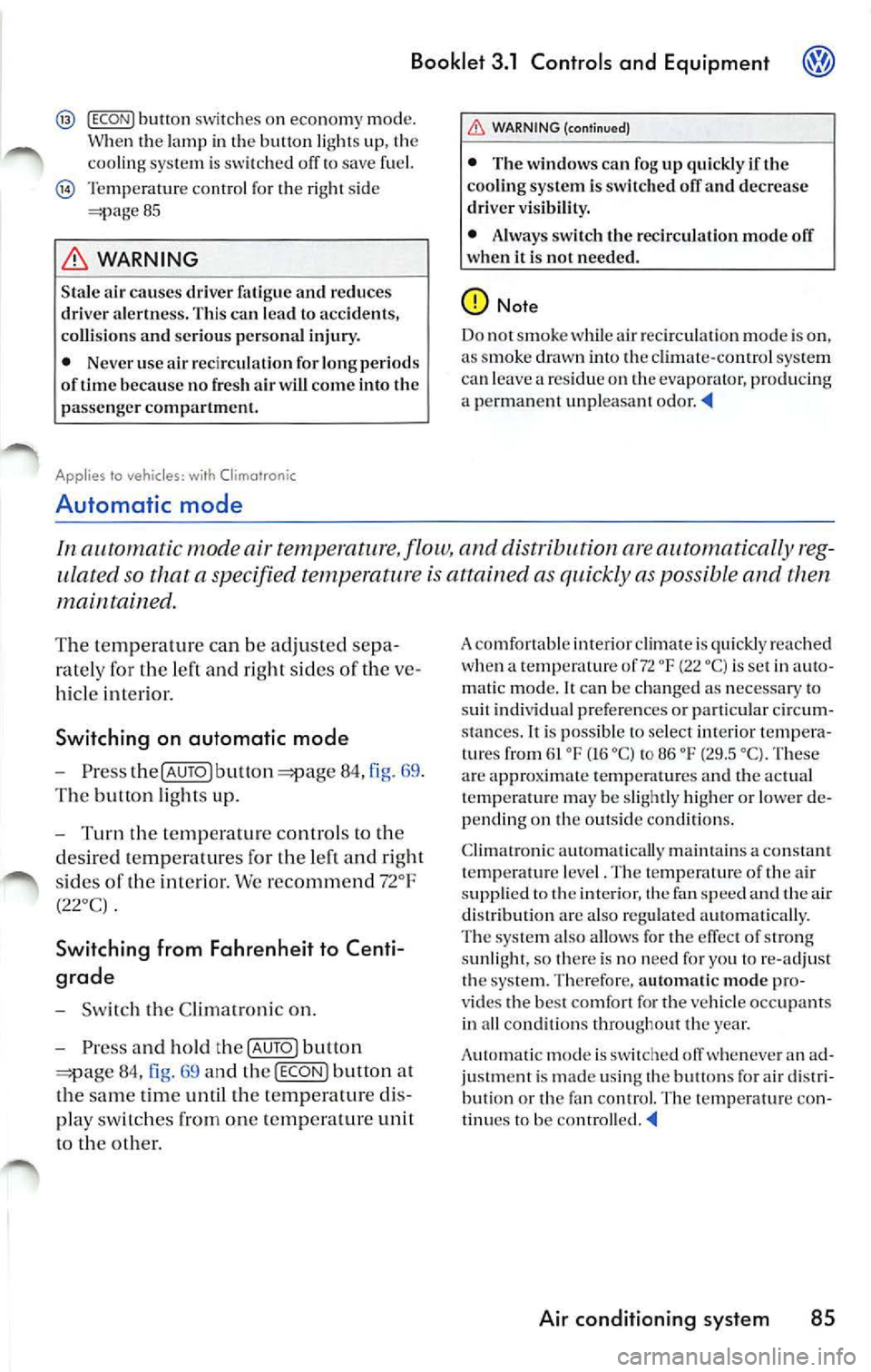
Booklet 3.1 Controls and Equipment
I ECONJ b utt on sw itche s on economy mode.
W hen t he in th e bu tton lights up , the
coo ling sys te m i s sw itch ed off to save fu el.
Temperat ure contro l fo r the r ig h t sid e
WARNING
Sta le air c auses driver fa tigue an d reduces
dr ive r ale rtn ess. T his ca n lead to accide nts,
c olli sio ns and ser iou s perso nal i njury.
• Neve r use a ir reci rc ul atio n for l ong peri ods
o f t im e beca use no fres h air will come in to th e
p assenger co mpa rtm ent.
Ap plies to vehicles: with Cli matronic
Automatic mode
WARN ING (con tinued)
• The w indows ca n fog up qu ick ly if th e
coo ling system is sw itch ed off a nd d ecrease
dri ver visib ility.
• Always switc h th e rec irc ulati on m ode
when is not nee ded .
Not e
Do no t smoke while air rec ircula tion mod e is o n,
a s s mok e
in to the cl imat e-co ntro l sys te m
ca n leave a residu e on the evaporator , producing
a permanent un pleasant odor.
In mode air temperature, flow, and dist ribution ar e automatically reg
ulat ed so that a specified temperature is attained as quickly as possible and then
maintained.
T he te m pera ture ca n be adjusted sepa
rately fo r th e
84, fig . 69 .
T he but ton li gh ts up .
- Turn t he tempera ture co ntro ls
1 0 th e
de sir ed te mpera tures fo r th e le ft and ri ght
s id es of the int erior. We recomm end
84, fig. 69 and th e !ECON ] button a t
th e same time unt il th e te mpera tu re di s
pl ay sw itch es from o ne te m pera tur e unit
t o t he ot her .
A c omfort ab le interior clima te is qu ickly re a ched
wh en a te mpera ture °F (22 °C) is se t in aut o
matic mode. It can be chang ed a s nec essary to
suit indi vid ual pre fe rences or parti cu lar cir cum
s ta nces . It i s po ssible to select interior te mpera
tur es from 61 °F (16 °CJ to 86 °F (29 .5 °CJ. These
ar e approxima te temp era tur es a nd the actual
t e mpera tu re ma y be sli gh tly hig h er or lo we r de
p end ing on t he ou ts id e co nditi ons.
C lim atroni c automa tica lly m aint ain s a con sta nt
t e m pera tu re leve l. Th e te mp erature of the air
s u pp lied to th e interior , th e fa n sp ee d and the air
di str ibution are also reg ulated a utomat ica lly.
T he sys te m als o all ows for th e effe ct of stro ng
s unl ig h t, so th ere is no nee d for you to r e-a dju st
th e sys tem. Therefo re, aut om atic mode pro
v id es th e be st comfort for the vehicle occ upant s
in all cond itio ns thro ugho ut the yea r.
A utom atic mode is switche d
an ad
justm en t is m ad e usin g th e but to ns fo r air dis tri
b ut io n or the fan control. The te m pera tu re co n
tinu es to be con tro lled.
Air conditi oning sy ste m 85
Page 291 of 477
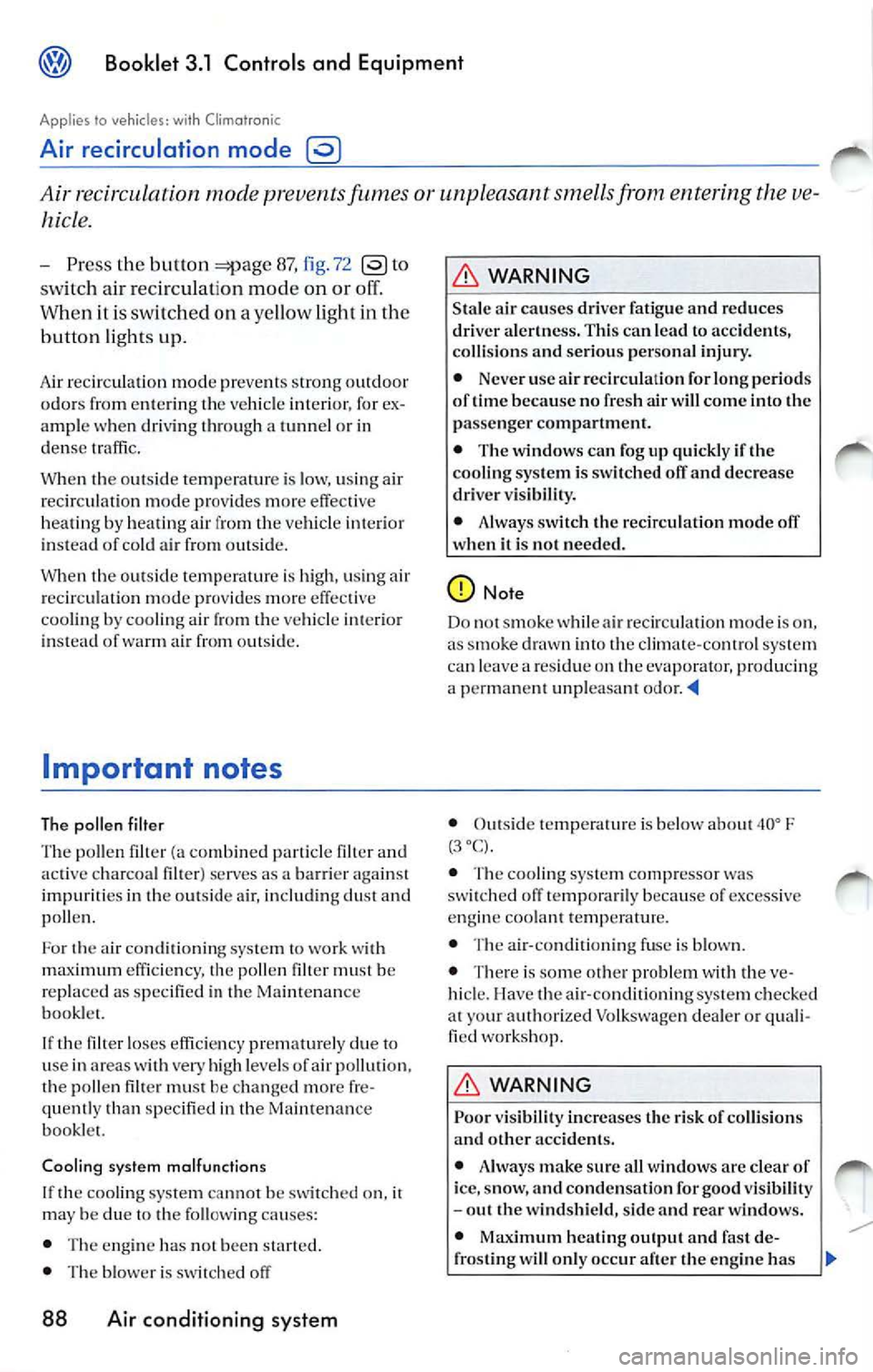
Booklet 3.1 Controls and Equipment
Applies to vehicles: with Climat ronic
Air recirculation mode
Air rec irculation mode prevents fumes or unpleasant smells from entering the ve
hicle.
- Press the but ton 87, 72 to
s witch air rec ircu lat ion mode on or off.
Wh en it i s switched o n a ye llow lig ht in the
button ligh ts up.
A ir reci rculati on mod e pr events stron g outd oor
odors from enter ing th e ve hicl e int eri or. for ex
a mpl e when dri ving through a tunnel o r in
dense traffic.
W hen th e o utsid e te mp eratur e is low , u sin g air
r ecirc ulatio n mod e pro vides mor e effec tive
h eat ing by hea ting air from th e veh icle inte rior
in stea d of co ld air from ou ts id e.
When the ou ts id e te mp era tur e is high. using air
recirc ulatio n mode provides m ore
coo ling by coo ling air fr om the ve hicle interior
in stea d of warm air from out sid e.
Important notes
T he pollen filter
The poll en filt er (a co mbin ed particl e filt er and
ac tive c harcoa l fil te r) se rves as a ba rr ier again st
impu rit ies in the outside air, includ ing dus t a nd
poll en.
Fo r th e air condi tio nin g sys te m
o ff
88 Air conditioning system
WARNING
Stale air causes driver fatigue and reduces
driver alertness. T his can lead to accidents ,
collisions and se rious personal injury.
• Neve r use air recircu latio n for long periods
of time because no fresh air will come into the
pa ssen ger compartment.
• The w indows can fog up quickl y if the
cooling system is switched off an d decrease
dri ver visibility.
• Always switch the recircu lat ion mod e off
w hen it is not ne ed ed.
Note
Do not sm oke whil e air rec ircul ation mod e is o n,
as sm oke drawn into th e cl im ate-co ntrol syste m
can le ave
res idu e on the evaporator, prod ucing
a per manent unpleasant odor. _,..
• Out side temperatur e is below abo ut 40° F
temperat ure.
• The air- co nditi onin g fu se is blow n.
• There is so me othe r prob le m with
ve
hicl e. Ha ve the air- co nditi onin g sys te m ch ec ked
a t yo ur auth orize d Vo lkswagen dea ler or quali
fi ed wo rks hop.
WARNING
Poor visibility increases the risk of collisions
an d ot her accide nts.
• Always make sure all windows are clear of
i ce, s now , and condens ati on for good v isib ility
- out the windshi eld, side and rear w indows.
• Maximum heating output and fa st de
fro stin g
only occ ur af ter the en gin e has
Page 293 of 477
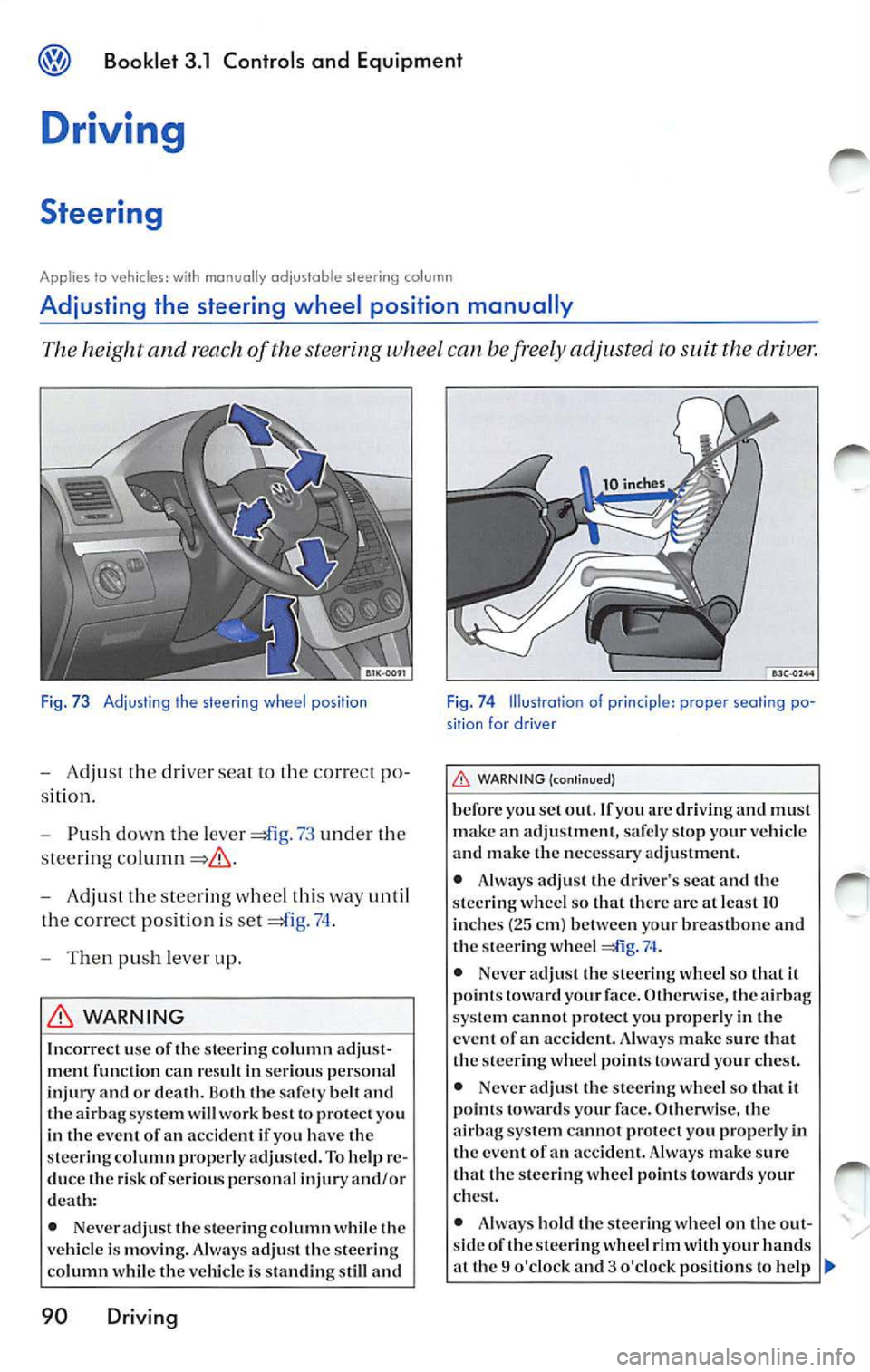
Booklet 3.1 Controls and Equipment
Driving
Steering
Applies lo vehicles: with manually adju stab le steering column
Adjusting the steering wheel position manually
The and reach of the steering whe el can be freely adjusted to suit the driver.
Fi g. 73 Adjusting the stee ring wheel position
- Adj ust the d river sea t to th e cor rect po
s it ion.
- Push dow n the leve r
73 und er th e
s tee rin g
- Adju st th e s teerin g w hee l thi s way until
the corre ct po siti on is se t
74 .
- Then push le ver up .
WARNING
Incorrect use of the steer ing co lumn adjust
ment function can in seriou s per sonal
in ju ry and or death. the sa fety bell and sys tem w ill work best to protec t yo u
in the event of an accident if yo u have the
s teering column properly adjusted. To help re
duce
ri sk of seriou s perso nal injury and /or
death:
• Neve r adjust
steering column whil e vehicle i s moving. Always ad just steering
co lumn whil e the vehicle is standing still and
90 Driving
Fig. 74 Illustratio n of prin ciple: proper seating po
sition for d river
WARN ING (continu ed)
b efore you se t out . If yo u are driving and must
ma ke an adju stment, safely slop your vehicl e
and make
necessary adjustment.
• Always adjust the dri ver 's s cat and the
s teer ing wheel so that there are at leas t 10
in che s (2 5 cm) between your brea stb one and
ste ering whee l
• Neve r adjust the stee ring wheel so Iha! ii points toward your face. Otherw ise, the a irb ag
syste m cann ot prote ct yo u proper ly in
eve nt of an accident. A lway s make sure that steer ing wh eel point s toward your chest .
• Neve r ad just the stee ring whee l so
points towards your face. O then vise, airbag system canno t p ro tect you properl y in eve nt of an accid ent . Always make sure
that the steerin g whe el po int s toward s your
c h es t.
• Alw ays hold
stee ring w heel on out
s id e of steering wheel rim with your hands
a t th e 9 o 'clock 3 o'clock posit ions to help
Page 294 of 477

Booklet 3.1 Controls and Equipment
WARNING (continued)
redu ce the risk of personal inju ry if the
driv er' s ai rbag infl ates.
• Neve r hold the ste er ing wheel at th e 12
o'cloc k po sition or with your hands a t other
positions insid e th e steeri ng whe el rim or on
t he steer ing wheel hub. I-foldin g th e s teerin g
whe el the wro ng way can cau se s eriou s inju-
Safety
WARNING (cont inu ed)
rics to th e han ds, a rms and head the driv er's
a irb ag inflat es.
• After adjus ting th e s teering wheel, always
pus h the stee ring wh eel a dju stment lever back
up as
as it will go. T his en sure s th e po siti on
of the st eering whee l ca nnot be alt ered unin
t e ntionally when the vehicle is moving.
Applies lo vehicles: wi th Electronic S ta biliza tion Progr am (E S P)
Electronic Stabilization Program
ESP helps mak e driving safer in certain situations.
Fi g. 75 D etail of the center console: bu tto n for ES P or ASR
Th e Electro nic Sta biliza tion Program (ESP) co n
tain s th e Ele ctro ni c Diff ere ntial Lock (ED L) and
t h e Anti -Slip Regu la tio n (A SH). Th e ESP works
to ge th er with the Anti -lo ck in g Brake System
( ABS ). Both warnin g lig hts w ill come o n if the
E SP or ABS sys te m s m alfu nct io n .
T he ES P is s ta rt ed a utomat ica lly w hen th e en
g in e is sta rt ed.
The ESP s hou ld ge nerall y be lef t sw itc hed on at
a ll tim es. In sp ecifi c circ um stan ces w here you
r e quir e less tract ion you ca n sw itch off th e ES P
by press ing buu on
75
For example: •
when dri vi ng w ith snow ch ain s,
• when dri vi ng in deep snow or on loo se sur
faces .
• when ro ckin g th e ve hicle backwa rd and for
wa rd to fre e it fro m mu d, for exa mple.
Yo u sh o uld press th e
to swi tc h th e back o n when you no longer need wh ee l spin .
Th e and ED Lare also sw itch ed off if th e ESP
i s sw it c h ed off. This means th at this te chn ology
i s not ava ilab le fo r as lo ng as th e ESP re ma in s
s w itc hed off.
When does the w ord OFF l ight up in the button
ESP?
• will lig ht up if th ere is a fault in the ES P.
• It will li gh t up if the ES P is sw itc hed off.
WARNING
• Always adjust your driv in g to th e road,
t raffic a nd weat her cond itions. Do not l et th e
extra sa fety that ESP can prov ide temp t you
int o tak ing extra risks.
• Always drive safel y.
• ESP and ASR cannot defy the laws of
ph ysics . Slipp ery and wet roads arc dangero us
eve n with ESP!
• ESP and
ca nnot re du ce the risk of ac
cident, for example if you drive too fast for
co nditi ons or if you do not keep your di sta nc e
fro m the vehicle in
of you.
Driving 91
Page 298 of 477

Booklet 3.1 Controls and Equ ipment
Starting and stopping the engine
Applies to vehic les : a gasoline engine
Starting the gasoline engine
Th e e ngi ne c an only be s tarted a g en uine Volkswagen key with th e corr ect
cod e.
M ove the s elec to r l eve r to P (Pa rk ) o r N
( N eutral )
98.
Depress the fo ot brak e. In vehicl es wi th
a m anual transmi ssion d epr ess the clut ch
p ed al.
Turn the ig niti on ke y to position
93 , 76 to start the engin e.
R elea se the ig nition k ey as soo n as the
e n gin e start s to avoid damagin g th e
s tart er.
Af ter s ta rtin g an en g in e th at is hot, yo u m ay
n ee d t o p ress the acce le rat or b riefl y.
W hen sta rtin g a co ld en gin e, it m ay be a
noisy fo r th e few seco nds oil pr ess ure
h as b uilt up i n th e hyd rau lic va lve li ft ers . Thi s is
n o rma l a nd n o cause for co nce rn.
I f th e en gin e does no t sta rt after
JO sec ond s,
sw itch off the ig n it io n, wait 30 seconds, then try
a g ain .
I f yo u have pro blem ssta rting=bookle t 3.2 "Tips
a nd
chapt er sta rtin g."
WARNING
Reduce the risk of ser iou s perso nal i nju ry
when st arting and run ning the vehicle' s en
g ine.
WARNING
• Nev er start or let the engine run in a co nor en clos ed are a. Exhau st from the en
g in e contain s carbo n mono xide, a poi sonous ,
c o lor le ss and odo rless ga s. C arbon monoxide
can c au se unconsciousne ss an d deat h.
• Never leave the ve hicle unattended with
the engine running. The vehicle could move
sudden ly or
unu sual operat ing cond ition
cou ld occur res ulting in property damage or
per sona l in ju ry.
• Never use "start ing assist fluids." Th ey are
potent ia ll y e xplo sive and can cause a "run
away" ve hicle condition.
Note
Y ou ca n da mage the e ngin e if yo u dri ve high en
g in e spee ds, a t full throttle or by ove rload ing th e
e n gin e w hen it i s c old.
ci> For th e sake of environmen t
Do n ot warm up th e engi ne by runnin g it w ith
th e ve hicl e sta ndin gstill. Drive off as soon as you
s ta rt th e eng ine. Thi s help s th e engin e reac h op
era tin g te mp era tu re fas te r a nd red uces
Driving 95